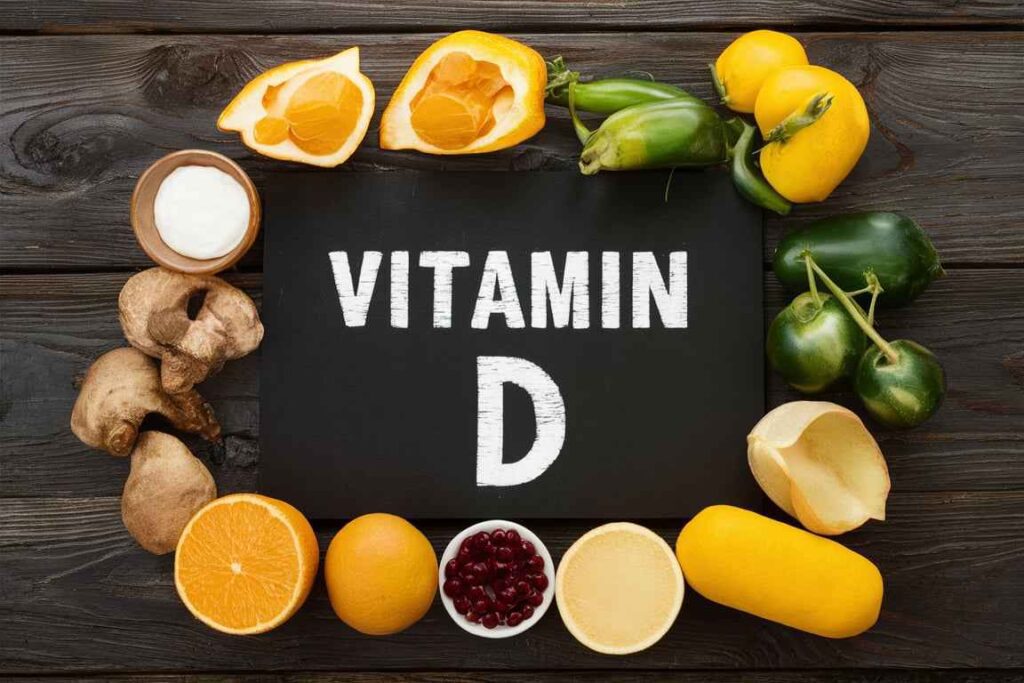Vitamin D, often called the sunshine vitamin, is essential for human health. Unlike most vitamins, our bodies can actually synthesize vitamin from sunlight exposure. It also comes from a few dietary sources. It plays a critical role in bone health, immune function, and cell growth
Table of Contents
Vitamin D
Vitamin D is a unique nutrient as it can be synthesized by the body through sunlight exposure and is also available through dietary sources and supplements. This fat-soluble vitamin plays a critical role in numerous physiological processes, particularly in maintaining bone health and supporting the immune system.

Synthesis
Cutaneous Synthesis:
- UVB Radiation: When exposed to ultraviolet B (UVB) rays from sunshine, a skin molecule called 7-dehydrocholesterol absorbs UVB radiation and converts it to previtamin D3.
- Thermal isomerization is a heat-dependent process that converts previtamin D3 to vitamin D3 (cholecalciferol). Skin pigmentation, age, geographic location, and sunscreen use can all have an impact on how efficiently this process works.
Dietary sources:
- Vitamin D2 (ergocalciferol) is mostly acquired from plant sources and fortified meals. Examples include mushrooms that have been exposed to sunlight.
- Animal-based foods containing vitamin D3 (cholecalciferol) include fatty fish (salmon, mackerel, sardines), fish liver oils, cow liver, egg yolks, and fortified goods such as milk and cereals.
Metabolism and Regulation
1. Liver:
The enzyme 25-hydroxylase hydroxylates vitamin D (both D2 and D3) to generate 25-hydroxyvitamin D [25(OH)D], also known as calcidiol. This is the primary circulating form and is used to determine it levels in the body.
2. Kidneys:
Calcidiol is further hydroxylated by the enzyme 1-alpha-hydroxylase, resulting in 1,25-dihydroxyvitamin D [1,25(OH)2D], commonly known as calcitriol, the physiologically active form of it.
3. Regulatory mechanisms:
When blood calcium levels are low, the parathyroid glands release PTH, which stimulates the kidneys to convert calcidiol to calcitriol.
Negative Feedback: Increased amounts of calcitriol inhibit future PTH production, hence regulating its own synthesis.
Biological Functions:
1. Calcium and Phosphate Homeostasis
Calcitriol improves the absorption of calcium and phosphate from the gut, which is essential for maintaining optimal blood levels of these minerals.
Bone Mineralization: Encourages the deposition of calcium and phosphate in bones, ensuring appropriate bone growth and strength.
2. Immune Systems:
Modulates both innate and adaptive immune responses. Calcitriol increases the antimicrobial activity of macrophages and other immune cells, which aids the body’s defense against infections.
3. Cells grow and differentiate:
Regulates cell proliferation and differentiation. This function is especially crucial in preventing unregulated cell proliferation, which can lead to cancer.
Sources

Sunlight
- Sunlight is the principal natural source. Most people can get enough vitamin from 10-30 minutes of noon sun exposure a few times each week. Latitude, season, skin pigmentation, and age are all factors that can influence synthesis.
Food:
- Natural sources include fatty fish, fish liver oils, egg yolks, and beef liver.
- Fortified Foods: Many countries add to milk, orange juice, cereals, and margarine.
Supplements: Available in two formats:
- Vitamin D2 (ergocalciferol) is less powerful and has a shorter duration of action than D3.
- Vitamin D3 (Cholecalciferol) is more effective at increasing and maintaining total vitamin levels in the body.
Deficiency

1. Causes:
- Insufficient sunshine exposure owing to lifestyle or geographical location.
- Poor dietary intake, particularly for people who have restricted access to vitamin D-rich or fortified foods.
- Malabsorption syndromes (such as Crohn’s disease and celiac disease) are conditions that limit fat-soluble vitamin absorption.
- Disorders of the liver or kidneys, which are necessary for converting vitamin to its active forms.
2. Symptoms:
- In children, rickets is characterized by bone abnormalities, slowed growth, and skeletal pain.
- In adults, osteomalacia causes bone softening, bone discomfort, and muscle weakness; it also increases the risk of osteoporosis, which causes brittle bones that are prone to fractures.
3. At-risk populations:
- Older persons have a diminished ability to manufacture it in their skin.
- Individuals with darker skin, which diminishes the skin’s capacity to generate it from sunlight.
- People living in northern latitudes with limited sunlight exposure, especially during winter months.
- Individuals with medical conditions affecting fat absorption or those who have undergone gastric bypass surgery.
Frequently Asked Question
Define Vitamin D.
Vitamin D is a unique nutrient as it can be synthesized by the body through sunlight exposure and is also available through dietary sources and supplements. This fat-soluble vitamin plays a critical role in numerous physiological processes, particularly in maintaining bone health and supporting the immune system.
What are the Sources of Vitamin D ?
The Sources of Vitamin D are
1. Sunlight light
2. Food
Related article
Vitamin E (Tocopherol): Biosynthesis, Biological roles and Deficiency

